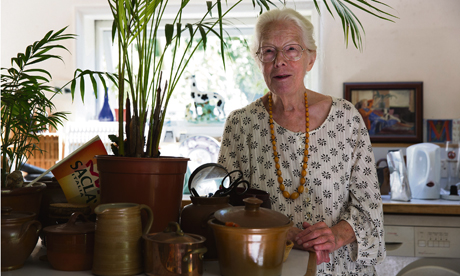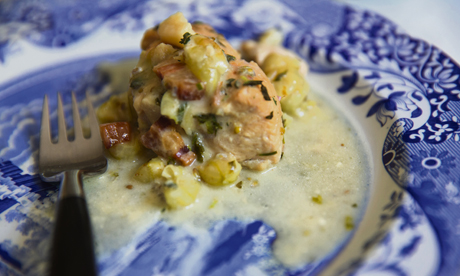Food historian Gillian Riley shows how to dine like a 15th century gastronome

Food historian Gillian Riley at her home in Stoke Newington. Photograph: Eleonore de Bonneval
Shopping for food in Hackney is pure pleasure.
I’ve done it every day for the past quarter of a century.
A greedy food historian searching for ingredients is like an urban fox rummaging in predictable and unexpected places and finding much to enjoy.
The greed is all the fault of my own far distant childhood, when the childcare guru Dr Trudy King terrorised innocent loving mums into draconian feeding schedules, with the result that I was always fractious and hungry.
I still am, but the food pleasures of Hackney have a benign effect. As I make my daily rounds, a modest shopping list often expands into heaving bags of treasures and a menu quite different from original expectations.
My move to Hackney two decades ago was strategic – it is a reasonably short bus-ride from the British Library and within walking distance from the St Bride Printing Library at Ludgate Circus.
But moving to Hackney from Camden meant leaving behind long-established food shops and markets, a leap into the unknown to what was then an unfashionable borough.
The run-down stretches of Stoke Newington High Road with its boarded-up shop fronts and burnt out cars slouching in side roads seemed a bit scary.
A cheap terraced house off Church Street was hardly enough of an incentive. But several reconnoitring expeditions later, the gastronomic lure of Hackney won me over – bags of early cherries from a Turkish store, a jar of tahini paste, a pot of rose petal jam, some pitta bread from the baker opposite, slabs of salty crumbly feta cheese and fresh vine leaves.
A family-run Italian restaurant by the old police station, now the deli Gallo Nero II, seemed a cheering sight. Their original deli in Newington Green became a trip well worth the walk or a short bus ride.
A really good butcher on Stoke Newington High Street, just opposite the Grade II listed building that is now Yum Yum seemed user friendly. I recall seeing one of the butchers rush out of the shop, bring the traffic to a screeching halt, and dash to catch up with the old lady who had forgotten her bag of mince.
Customers are cared for round here.
When, come marmalade time, the modest English greengrocers in Church Street said they would not be having any Seville oranges, I said I’d buy a crate.
Later they did a roaring trade, handy for those who use bitter orange juice in Renaissance recipes in place of lemon juice.
The Indian shop next to the post office had a huge range of spices, fresh chillies and ginger, fresh curry leaves, and hidden away in the back, packets of the multi-coloured sugar-coated confetti that figured in Italian Renaissance banquet menus.
These comfits must have come to Europe as part of the Arab gastronomic heritage, filtering north from Muslim Arab Spain and Southern Italy, or maybe later in the kitbags of entranced Crusaders.
Rosewater was there too, another Arab gift and an essential item in the hand-washing ceremonies at historic banquets.
Orange blossom water was on sale in the Turkish shops. You can sprinkle it over a rice pudding perfumed with mastic and orange peel, a living link with the past.
But the gastronomic quest for me has always been for things Italian, the essential ingredients for cooking and eating the food that became my passion.
This began a long time ago, when travelling in Italy took me and my husband off the tourist tracks and to places where honest local food was to be found.
As a historian struggling with texts in sometimes impenetrable early Italian and Spanish, I regard Hackney as a splendid resource.
It is a living A to Z of food traditions and ingredients.
So a daily shopping expedition could be to get ingredients for a historic Italian recipe or a search for inspiration.
A lovely chicken dish from 15th century Italy was not difficult to source.
The recipe below comes from the famous 15th century culinary expert Maestro Martino, whose cookery manuscript was written out by the foremost calligrapher of the time, Bartolomeo Sanvito.
I buy the pancetta from Gallo Nero II on Stoke Newington High Street and the fresh herbs from one of the Turkish shops.
For the verjuice the recipe required would have been unripe green grapes with pips removed, or the hard unripe little green plums which arrive from Turkey in late spring, or our own gooseberries from Stoke Newington Farmers’ Market in early summer. I find it’s lovely with a crisp glass of verdicchio.

Chicken with verjuice. Photograph: Eleonore de Bonneval
Chicken with verjuice
Ingredients…
Serves four
four chicken joints
1oog pancetta, unsmoked, cut into dice
chopped garlic to taste
250g green gooseberries topped and tailed
or unripe grapes, pips removed
or some bottled verjuice
one glass of dry white wine
sugar to taste
one handful fresh herbs, chopped: basil, marjoram, parsley, mint
olive oil for frying
Directions…
Fry the chicken joints and pancetta together until the chicken is golden, add the garlic but don’t let it brown. Then tip in the wine and cook fast until almost evaporated. Leave to simmer until the chicken is cooked and there is little liquid. Add the prepared grapes or gooseberries and cook through until they are soft, and taste, adding sugar to balance the acidity. Then stir in the herbs and serve. A little crème fraîche is good, although not in the original recipe.
Gillian Riley is a food writer and the author of The Oxford Companion to Italian Food
